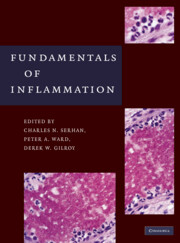Book contents
- Frontmatter
- Contents
- Contributors
- Preface
- PART I THE INFLAMMATORY RESPONSE – AN OVERVIEW
- PART II INDIVIDUAL CELL TYPES
- PART III CHEMICAL MEDIATORS
- PART IV IMMUNOPHARMACOLOGY
- 17 Mediators and Mechanisms of Inflammatory Pain
- 18 Nonsteroidal Anti-Inflammatory Drugs
- 19 Cytokines and Chemokines in Inflammation and Cancer
- PART V INFLAMMATORY DISEASES/HISTOLOGY
- PART VI ANIMAL MODELS OF INFLAMMATION
- Index
- References
17 - Mediators and Mechanisms of Inflammatory Pain
from PART IV - IMMUNOPHARMACOLOGY
Published online by Cambridge University Press: 05 April 2014
- Frontmatter
- Contents
- Contributors
- Preface
- PART I THE INFLAMMATORY RESPONSE – AN OVERVIEW
- PART II INDIVIDUAL CELL TYPES
- PART III CHEMICAL MEDIATORS
- PART IV IMMUNOPHARMACOLOGY
- 17 Mediators and Mechanisms of Inflammatory Pain
- 18 Nonsteroidal Anti-Inflammatory Drugs
- 19 Cytokines and Chemokines in Inflammation and Cancer
- PART V INFLAMMATORY DISEASES/HISTOLOGY
- PART VI ANIMAL MODELS OF INFLAMMATION
- Index
- References
Summary
After tissue injury or exposure of the organ to a foreign body or infectious entity, a complex cascade of cellular and humoral events is initiated. These events, observed in virtually every organ system, including skin, muscle, meninges, dentition, bone, and visceral tissues, fall broadly under the rubric of “inflammation.” In general, this cascade serves to protect and maintain the functional integrity of the systems in the face of insult. The process activates the immune system and directs chemotactic agents, neutrophils, and mononuclear cells to migrate from the vascular bed to the injury site. The cardinal clinical signs of this process, rubor/calor (increased local blood flow) and tumor (swelling secondary to local plasma extravasation) are manifested to varying degrees in all of these tissues. The fourth cardinal sign, dolor (pain), typically accompanies such cascades. The biological processes whereby these inflammatory cascades serve to initiate and sustain a pain state are the focus of this commentary.
INFLAMMATORY PAIN PHENOTYPE
The acute application of a thermal or mechanical stimulus of such intensity as to potentially produce tissue injury will typically evoke a somatic escape response (e.g., a withdrawal of the stimulated limb) and an autonomic response (e.g., hypertension and tachycardia), a syndrome classically referred to by Sherrington as a nociceptive reflex [1]. These acute responses typically display four characteristics: (i) the magnitude of these responses varies directly with stimulus intensity; (ii) the latency varies inversely with stimulus intensity; (iii) the focus of the response is referred to as the specific site of stimulation (e.g., it is homotopic); and (iv) in the absence of tissue injury, removal of the acute stimulus results in a rapid attenuation of the sensation and the attendant behaviors.
- Type
- Chapter
- Information
- Fundamentals of Inflammation , pp. 217 - 233Publisher: Cambridge University PressPrint publication year: 2010



